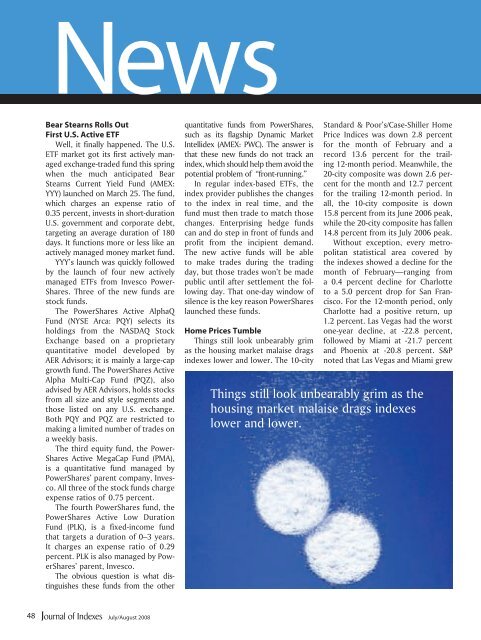Download - IndexUniverse.com
Download - IndexUniverse.com
Download - IndexUniverse.com
Create successful ePaper yourself
Turn your PDF publications into a flip-book with our unique Google optimized e-Paper software.
News<br />
Bear Stearns Rolls Out<br />
First U.S. Active ETF<br />
Well, it finally happened. The U.S.<br />
ETF market got its first actively managed<br />
exchange-traded fund this spring<br />
when the much anticipated Bear<br />
Stearns Current Yield Fund (AMEX:<br />
YYY) launched on March 25. The fund,<br />
which charges an expense ratio of<br />
0.35 percent, invests in short-duration<br />
U.S. government and corporate debt,<br />
targeting an average duration of 180<br />
days. It functions more or less like an<br />
actively managed money market fund.<br />
YYY’s launch was quickly followed<br />
by the launch of four new actively<br />
managed ETFs from Invesco Power-<br />
Shares. Three of the new funds are<br />
stock funds.<br />
The PowerShares Active AlphaQ<br />
Fund (NYSE Arca: PQY) selects its<br />
holdings from the NASDAQ Stock<br />
Exchange based on a proprietary<br />
quantitative model developed by<br />
AER Advisors; it is mainly a large-cap<br />
growth fund. The PowerShares Active<br />
Alpha Multi-Cap Fund (PQZ), also<br />
advised by AER Advisors, holds stocks<br />
from all size and style segments and<br />
those listed on any U.S. exchange.<br />
Both PQY and PQZ are restricted to<br />
making a limited number of trades on<br />
a weekly basis.<br />
The third equity fund, the Power-<br />
Shares Active MegaCap Fund (PMA),<br />
is a quantitative fund managed by<br />
PowerShares’ parent <strong>com</strong>pany, Invesco.<br />
All three of the stock funds charge<br />
expense ratios of 0.75 percent.<br />
The fourth PowerShares fund, the<br />
PowerShares Active Low Duration<br />
Fund (PLK), is a fixed-in<strong>com</strong>e fund<br />
that targets a duration of 0–3 years.<br />
It charges an expense ratio of 0.29<br />
percent. PLK is also managed by PowerShares’<br />
parent, Invesco.<br />
The obvious question is what distinguishes<br />
these funds from the other<br />
quantitative funds from PowerShares,<br />
such as its flagship Dynamic Market<br />
Intellidex (AMEX: PWC). The answer is<br />
that these new funds do not track an<br />
index, which should help them avoid the<br />
potential problem of “front-running.”<br />
In regular index-based ETFs, the<br />
index provider publishes the changes<br />
to the index in real time, and the<br />
fund must then trade to match those<br />
changes. Enterprising hedge funds<br />
can and do step in front of funds and<br />
profit from the incipient demand.<br />
The new active funds will be able<br />
to make trades during the trading<br />
day, but those trades won’t be made<br />
public until after settlement the following<br />
day. That one-day window of<br />
silence is the key reason PowerShares<br />
launched these funds.<br />
Home Prices Tumble<br />
Things still look unbearably grim<br />
as the housing market malaise drags<br />
indexes lower and lower. The 10-city<br />
Standard & Poor’s/Case-Shiller Home<br />
Price Indices was down 2.8 percent<br />
for the month of February and a<br />
record 13.6 percent for the trailing<br />
12-month period. Meanwhile, the<br />
20-city <strong>com</strong>posite was down 2.6 percent<br />
for the month and 12.7 percent<br />
for the trailing 12-month period. In<br />
all, the 10-city <strong>com</strong>posite is down<br />
15.8 percent from its June 2006 peak,<br />
while the 20-city <strong>com</strong>posite has fallen<br />
14.8 percent from its July 2006 peak.<br />
Without exception, every metropolitan<br />
statistical area covered by<br />
the indexes showed a decline for the<br />
month of February—ranging from<br />
a 0.4 percent decline for Charlotte<br />
to a 5.0 percent drop for San Francisco.<br />
For the 12-month period, only<br />
Charlotte had a positive return, up<br />
1.2 percent. Las Vegas had the worst<br />
one-year decline, at -22.8 percent,<br />
followed by Miami at -21.7 percent<br />
and Phoenix at -20.8 percent. S&P<br />
noted that Las Vegas and Miami grew<br />
Things still look unbearably grim as the<br />
housing market malaise drags indexes<br />
lower and lower.<br />
48<br />
July/August 2008
















